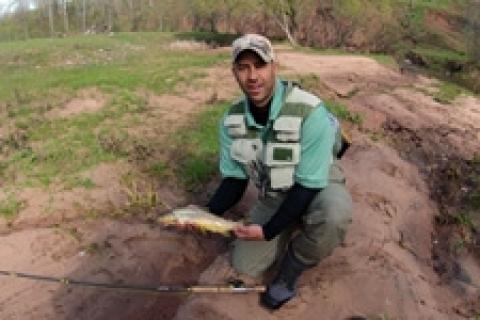
 To beat the heat of the dog days of summer, nothing compares to wet wading in your favorite bodies of water. Rivers and streams this time of year are normally running low and clear, making catching trout difficult even for the seasoned angler. Many anglers fly fish with the perspective that large terrestrial patterns (hoppers, crickets) are the only way to go this time of year because of the sheer abundance of these critters. Yes, grasshopper patterns will catch fish and they can be fun to watch fish rise too, but in these dry, hot situations big flies can and will spook skittish fish.
To beat the heat of the dog days of summer, nothing compares to wet wading in your favorite bodies of water. Rivers and streams this time of year are normally running low and clear, making catching trout difficult even for the seasoned angler. Many anglers fly fish with the perspective that large terrestrial patterns (hoppers, crickets) are the only way to go this time of year because of the sheer abundance of these critters. Yes, grasshopper patterns will catch fish and they can be fun to watch fish rise too, but in these dry, hot situations big flies can and will spook skittish fish.
One of the least popularized hatches that fly anglers need to get to know for fishing the late summer months is the Tricos hatch (Tricorythodes). In Wisconsin, these Mayflies start to emerge late July through October and can be a consistent way for anglers to catch trout.
Tricos can hatch at several different times throughout the day, but the important hatch for fly anglers to target is the females emerging. In the summer this happens at first light, but it also can occur later in the afternoon as the weather starts to cool. The female emergence can be fun to fish as the flies come off the water but its action still does not compare to the spinner fall. Tricos return to the water as spinners sometime after emerging, it can be anywhere from minutes to hours. As the mating spinners return they will concentrate in very tight swarms in a few locations over the river. Fish will key in on these swarms and wait for the mating process to take place and for the males to fall to water. With the large number of flies falling to the water's surface it doesn't take long for fish to get excited and start feeding heavily on the helpless insects.
The tough part to fishing the Tricos hatch is there respected size. In most cases these mayflies are somewhere between sizes 18-24. Trout feeding on Tricos can be ultra-sensitive to what you are presenting. If the fly you choose is too big even by a few millimeters it can make a world of difference and leave you fishless.
The other problem is that even though you might be able to get fish to rise to what you are offering, hooking and holding a quality trout on a size 20 or better fly is just not an easy task. The few tips I can give are to carry flies in varying sizes and change frequently if you are not getting any attention from fish. Secondly to set the hook with these small flies, employ a slow pull for a hook set rather than to snapping the rod back when you see the fish feed. Lastly is helpful to use a 9-foot tapered leader with these small flies. You will need a very fine leader to just tie the fly on, but the lighter the tip is on the leader the more natural the fly will drift on the water.
The Tricos hatch can be a new and challenging way for anglers to target trout on their favorite rivers and streams. Take the time to learn the behavior of these insects and you won't be disappointed.
- 3302 views

